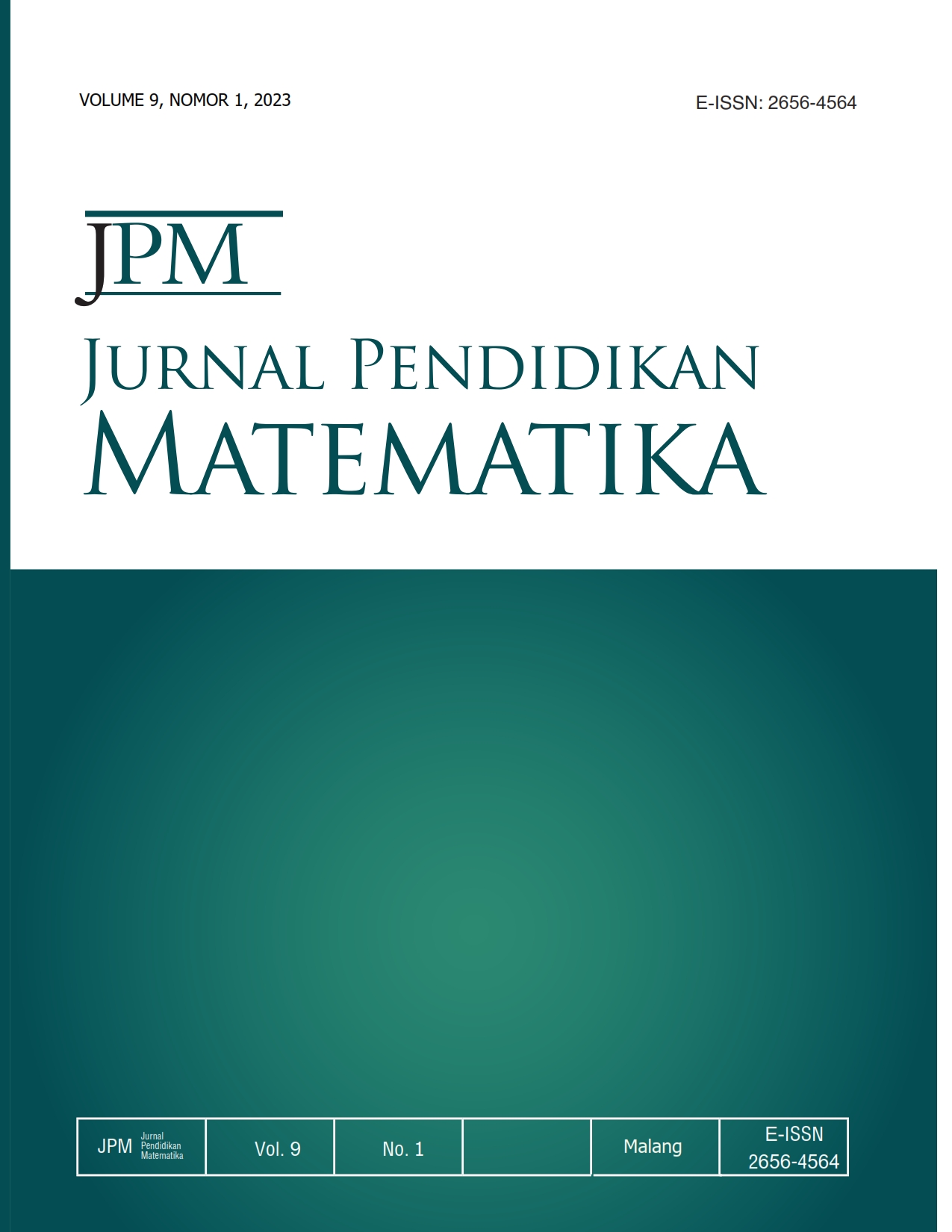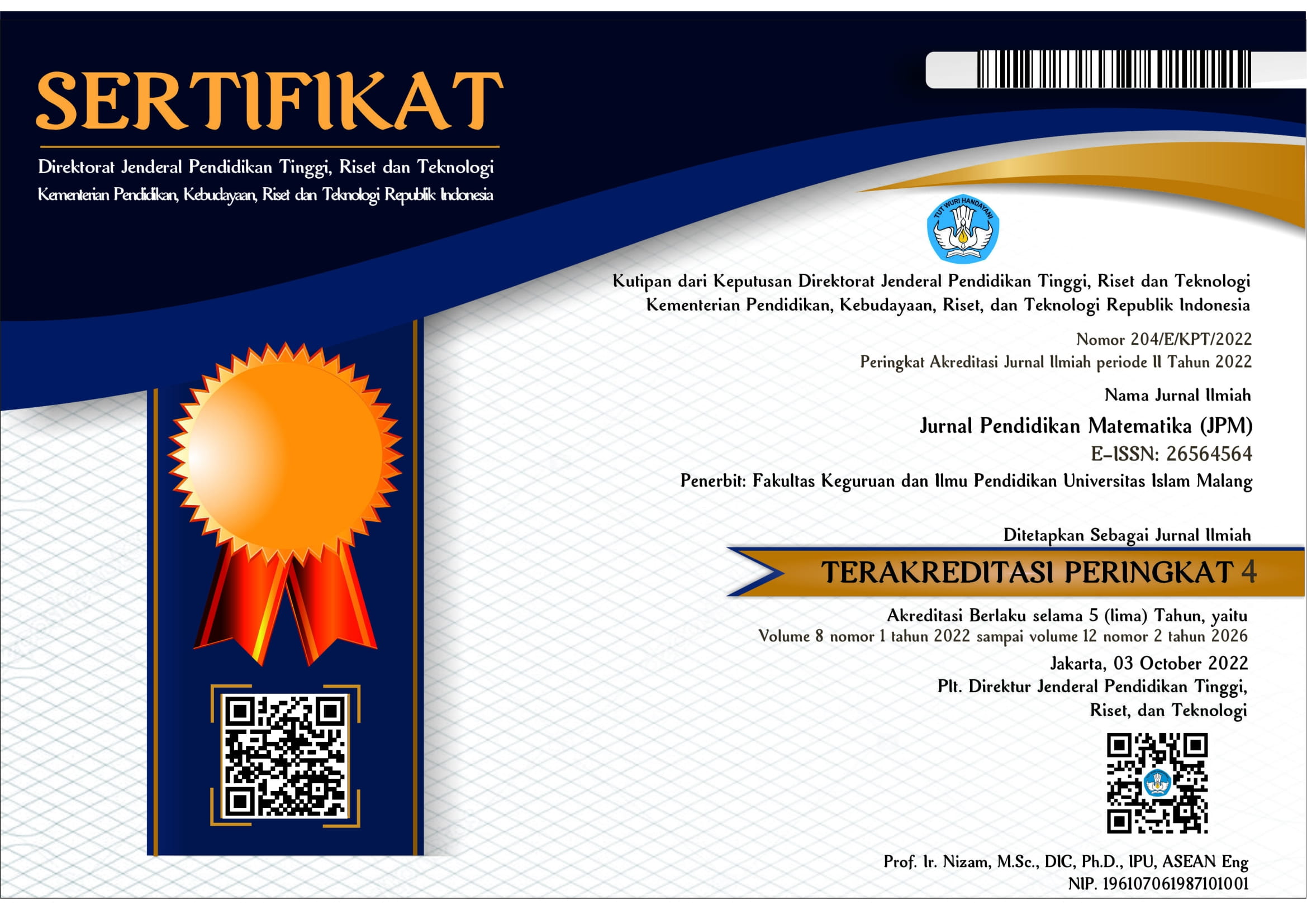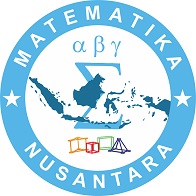Design of Realistic Mathematics Education Digital (RMED) in Era Society 5.0
DOI:
https://doi.org/10.33474/jpm.v9i1.19358Keywords:
design, RME, digital, society 5.0Abstract
The era of society 5.0 is an era where technology becomes part of humans, in this era education is transformed into digital. This research is a descriptive qualitative research. The purpose of this study is to describe how the RMED design is in the era of society 5.0. data collection was done through literature study, in-depth interviews with teachers and students. The data obtained were then analyzed with a qualitative approach. The results of the study indicate that there is a need for further research and development related to RMED in the era of society 5.0
References
Anis, Arifin dan Mardiani. (2022). Digitalisasi Sumber Belajar Sejarah Menyongsong Pendidikan Era 4.0. Di seminar Nasional Lingkungan Lahan Basah. 118-124
Chesser, L. (2013). Modern Trends in Education: 50 Different Approaches To Learning. Teachthought.
Davies R. (2015). Industry 4.0; Digitalisation for productivity and growth. Eur Parliam Res Serv.
Faruqi, U. A. (2019). Survey Paper : Future Service In Industry 5.0. Jurnal Sistem Cerdas 02 (01) , 67–79.
Freudenthal, H. (1983). Mathematics as an Educational Task. Dordrecht: D.Reidel Publising Co.
Fukuyama, M. (2018). Society 5.0: Aiming for a New Human-Centered Society. Japan SPOTLIGHT, 47-50.
Gravemeijer, K. P. (1994). Developing realistic Mathematics Education (Ontwikkelen van realistisch reken/wiskundeonderwijs). Freudenthal Institute, Utrecht, The Netherlands.
Hasbi, M, Lukito, A., & Sulaiman, R. (2019). Mathematical Connection Middle-School Students 8th in Realistic Mathematics Education. Journal of Physics: Conference Series, 1417(1), 012047, IOP Publishing.
Helmiati. (2012). Model Pembelajaran. Sleman: Aswaja Pressindo.
Jayanti, Jumroh, Ernawati Dan Nur Endah. (2021). Pembelajaran Geometri Melalui Pmri Berbantuan Elearning Di Masa Covid-19 Pada Mahasiswa Universitas Pgri Palembang. Prosiding Seminar Nasional Pgri Provinsi Sumatera Selatan Dan Universitas Pgri Palembang 2 November 2021.
Khasanah, U., Hernia, H. (2019). Membangun karakter siswa melalui literasi digital dalam menghadapi pendidikan abad 21 (revolusi industri 4.0). Prosiding Seminar Nasional Pendidikan Program Pascasarjana Universitas Palembang, 999-1015.
Kistofer, Permadi, and Vitadiar. (2019). Development of Digital System Learning Media Using Digital Learning System. In 1st Vocational Education International Conference (VEIC 2019), pp. 177–182.
Kwon, O. N. (2002). Conceptualizing the Realistic Mathematics Education Approach in the Teaching and Learning of Ordinary Differential Equations. Journal of the Korea Society of Mathematical Education Series: Research in Mathematical Education Vol. 6, No. 2.
Ningsih, S., (2017). Realistic Mathematics Education: Model Alternatif Pembelajaran
Matematika Sekolah. JPM IAIN, 1(2): 73-94.
Özdemir, V. &. (2018). Birth Of Industry 5.0: Making Sense Of Big Data With Artificial Intelligence,“The Internet Of Things” And Next-Generation Technology Policy. Omics: A Journal Of Integrative Biology 22(1) , 65-76.
Parwati, Ni Putu Yuniarika dan I Nyoman Bayu Pramartha. (2021).Strategi Guru Sejarah dalam Menghadapi Tantangan Pendidikan Indonesia di Era Society 5.0. Widyadari Jurnal Pendidikan, 22(1), 143-158.
Pebriana, P. H., (2017). Peningkatan Hasil Belajar Matematika Dengan Menerapkan Pendekatan Pendidikan Matematika Realistik Indonesia (PMRI) Pada Siswa Kelas V SDN 003 Bangkinang. Jurnal Cendekia: Jurnal Pendidikan Matematika, 1(1): 68-79.
Pinatih, Ni Putu Sri. (2020). Pembelajaran Menyenangkan dalam Menyongsong Era Society 5.0. Di Webinar Nasional IAHN-TP Palangka Raya. 64-76.
Pramesti. (2018). Penggunaan Digital Learning System (Dls) Sebagai Pembelajaran Berbasis Teknologi Di Smp Negeri 5 Surabaya. Surabaya: Universitas Airlangga
Sari, Zuli Nuraeni, Novika Sukmaningthias. (2022). Interaction between RME-based blended learning and self-regulated learning in improving mathematical literacy. Jurnal Elemen, 8(2), 631-644, https:/doi.org/10.29408/jel.v8i2.5751.
Siregar & Hasratuddin. (2022). Pengaruh Pendekatan Matematika Realistik Berbantuan Macromedia Flash Terhadap Kemampuan Pemecahan Masalah Matematika Siswa Berbasis Gender Di Kelas VII SMP Negeri 29 Medan. Humantech Jurnal Ilmiah Multi Disiplin Indonesia Vol 1 (10).
Skobelev, P., & Borovik, Y. S. (2017). On The Way From Industri 4.0 To Industri 5.0: From Digital Manufactureing To Digital Society. International Scientific Research Journal Industri 4.0 , 307-311.Streefland, L. (1991). Realistic Mathematics Education in Primary school. Freudenthal Institute: Utreeht.
Suherman, Musnaini, Hadion Wijoyo dan Irjus Indrawan. (2020). INDUSTRY 4.0 VS SOCIETY 5.0. Banyumas: Pena Persada.
Sumarno, S. (2019). Pembelajaran Kompetensi Abad 21 Menghadapi Era Society 5.0. Prosiding SEMDIKJAR (Seminar Nasional Pendidikan Dan Pembelajaran), 3, 272-287.
Suparni. (2020). Efektivitas Pendekatan Pendidikan Matematika Realistik Indonesia (
PMRI ) Terhadap Kemampuan Pemecahan Masalah Dan Self-Efficacy Siswa
Smp / Mts. JPMI: Jurnal Pembelajaran Matematika Inovatif, 3(4), 293 – 302.
Treffers, A. (1987). Three dimensions. Amodel of goal and theory description in mathematics education. Dordrecht, the Netherlands: Reidel.
Trilling, B & Fadel, C. (2009). 21st-century skills: learning for life in our times. US: Jossey-Bass A Wiley Imprint.
Webb, D. C., Van der Kooij, H., & Geist, M. R. (2011). Design research in the Netherlands: Introducing logarithms using realistic mathematics education. Journal of Mathematics Education at Teachers College, 2(1).
Downloads
Published
How to Cite
Issue
Section
License
Copyright (c) 2023 MEILANI SAFITRI, M.RIDWAN AZIZ

This work is licensed under a Creative Commons Attribution 4.0 International License.






_-_Copy.jpg)
.jpg)
.jpg)










